Higher-Order-Mode Triple Band Circularly Polarized Rectangular Dielectric Resonator Antenna
Abstract
1. Introduction
2. Materials and Methods
2.1. Single Stub Feed DR Antenna (DRA1)
2.2. Double Stub Feed DR Antenna (DRA2)
2.3. Double Stub Feed DR Antenna with Parasitic Patch (DRA3)
3. Measurement Results and Discussion
4. Conclusions
Author Contributions
Funding
Institutional Review Board Statement
Informed Consent Statement
Acknowledgments
Conflicts of Interest
References
- Varshney, G.; Gotra, S.; Pandey, V.S.; Yaduvanshi, R.S. Inverted-Sigmoid Shaped Multiband Dielectric Resonator Antenna with Dual-Band Circular Polarization. IEEE Trans. Antennas Propag. 2018, 66, 2067–2072. [Google Scholar] [CrossRef]
- Li, B.; Leung, K.W. Strip-fed rectangular dielectric resonator antennas with/without a parasitic patch. IEEE Trans. Antennas Propag. 2005, 53, 2200–2207. [Google Scholar]
- Altaf, A.; Seo, M. Triple-band dual-sense circularly polarized hybrid dielectric resonator antenna. Sensors 2018, 18, 3899. [Google Scholar] [CrossRef]
- Yasin, M.N.M.; Khamas, S.K. Measurements and analysis of a probe-fed circularly polarized loop antenna printed on a layered dielectric sphere. IEEE Trans. Antennas Propag. 2012, 60, 2096–2100. [Google Scholar] [CrossRef]
- Mongia, R.K.; Ittipiboon, A. Theoretical and experimental investigations on rectangular dielectric resonator antennas. IEEE IEEE Trans. Antennas Propag. 1997, 45, 1348–1356. [Google Scholar] [CrossRef]
- Fang, X.; Leung, K.W.; Lim, E.H. Singly-Fed Dual-Band Circularly Polarized. IEEE Antennas Wirel. Propag. Lett. 2014, 13, 995–998. [Google Scholar] [CrossRef]
- Zou, M.; Pan, J. Wide Dual-Band Circularly Polarized Stacked Rectangular Dielectric Resonator Antenna. IEEE Antennas Wirel. Propag. Lett. 2016, 15, 1140–1143. [Google Scholar] [CrossRef]
- Illahi, U.; Iqbal, J.; Sulaiman, M.I.; Alam, M.; Su’ud, M.M.; Khattak, M.I. Design and development of a singly-fed circularly polarized rectangular dielectric resonator antenna for WiMAX/Satellite/5G NR band applications. AEU Int. J. Electron. Commun. 2020, 126, 153443. [Google Scholar] [CrossRef]
- Illahi, U.; Iqbal, J.; Sulaiman, M.I.; Alam, M.; Su’ud, M.M.; Jamaluddin, M.H. Singly-Fed Rectangular Dielectric Resonator Antenna with a Wide Circular Polarization Bandwidth and Beamwidth for WiMAX/Satellite Applications. IEEE Access 2019, 7, 66206–66214. [Google Scholar] [CrossRef]
- Illahi, U.; Iqbal, J.; Sulaiman, M.I.; Alam, M.; Su’ud, M.M.; Jamaluddin, M.H.; Yasin, M.A.M. Design of new circularly polarized wearable dielectric resonator antenna for off-body communication in WBAN applications. IEEE Access 2019, 7, 150573–150582. [Google Scholar] [CrossRef]
- Cheng, C.; Zhang, F.; Yao, Y.; Zhang, F. Triband Omnidirectional Circularly Polarized Dielectric Resonator Antenna with Top-Loaded Alford Loop. Int. J. Antennas Propag. 2014, 2014, 1–8. [Google Scholar] [CrossRef]
- Zhao, Z.; Ren, J.; Liu, Y.; Yin, Y. Wideband Dual-Feed, Dual-Sense Circularly Polarized Dielectric Resonator Antenna. IEEE Trans. Antennas Propag. 2020, 68, 7785–7793. [Google Scholar] [CrossRef]
- Ogurtsov, S.; Koziel, S.; Bekasiewicz, A. Axial ratio improvement of circular polarized dielectric resonator antennas with dual-point feeds. In Proceedings of the 2016 IEEE/ACES International Conference on Wireless Information Technology, ICWITS 2016 and System and Applied Computational Electromagnetics, ACES 2016—Proceedings, Honolulu, HI, USA, 13–18 March 2016; Volume 2, pp. 1–2. [Google Scholar]
- Wang, M.; Chu, Q.-X. A Wideband Polarization-Reconfigurable Water Dielectric Resonator Antenna. IEEE Antennas Wirel. Propag. Lett. 2019, 18, 402–406. [Google Scholar] [CrossRef]
- Chen, Z.; Wong, H. Liquid Dielectric Resonator Antenna with Circular Polarization Reconfigurability. IEEE Trans. Antennas Propag. 2018, 66, 444–449. [Google Scholar] [CrossRef]
- Abdulmajid, A.A.; Khalil, Y.; Khamas, S. Higher-order-mode circularly polarized two-layer rectangular dielectric resonator antenna. IEEE Antennas Wirel. Propag. Lett. 2018, 17, 1114–1117. [Google Scholar] [CrossRef]
- Altaf, A.; Jung, J.; Yang, Y.; Lee, K.-Y.; Hwang, K.C. ; Lee, K.-Y.; Hwang, K.C. Reconfigurable Dual- / Triple-Band Circularly Polarized Dielectric Resonator Antenna. IEEE Antennas Propag. Lett. 2020, 19, 443–447. [Google Scholar] [CrossRef]
- Gupta, A.; Gangwar, R.K. Dual-Band Circularly Polarized Aperture Coupled Rectangular Dielectric Resonator Antenna for Wireless Applications. IEEE Access 2018, 6, 11388–11396. [Google Scholar] [CrossRef]
- Liu, Y.; Jiao, Y.C.; Weng, Z.; Zhang, C.; Chen, G. A novel millimeter-wave dual-band circularly polarized dielectric resonator antenna. Int. J. Rf Microw. Comput. Eng. 2019, 29, 930–933. [Google Scholar] [CrossRef]
- Belen, M.A.; Mahouti, P.; Palandöken, M. Design and realization of novel frequency selective surface loaded dielectric resonator antenna via 3D printing technology. Microw. Opt. Technol. Lett. 2020, 62, 2004–2013. [Google Scholar] [CrossRef]
- Hayat, T.; Afzal, M.U.; Lalbakhsh, A.; Esselle, K.P. Additively manufactured perforated superstrate to improve directive radiation characteristics of electromagnetic source. IEEE Access 2019, 7, 153445–153452. [Google Scholar] [CrossRef]
- Adibi, S.; Honarvar, M.A.; Lalbakhsh, A. Gain enhancement of wideband circularly polarized UWB antenna using FSS. Radio Sci. 2021, 56. [Google Scholar] [CrossRef]
- Lalbakhsh, A.; Karu, P.E. Directivity improvement of a fabry-perot cavity antenna by enhancing near field characteristic. In Proceedings of the 2016 17th International Symposium on Antenna Technology and Applied Electromagnetics (ANTEM), Quebec, Canada, 10 July 2016; pp. 1–2. [Google Scholar]
- Lalbakhsh, A.; Muhammad, U.A.; Karu, P.E.; Stephanie, L.S. Low-cost nonuniform metallic lattice for rectifying aperture near-field of electromagnetic bandgap resonator antennas. IEEE Trans. Antennas Propag. 2020, 68, 3328–3335. [Google Scholar] [CrossRef]
- Sharma, A.; Sarkar, A.; Biswas, A.; Akhtar, M.J. A-shaped wideband dielectric resonator antenna for wireless communication systems and its MIMO implementation. Int. J. Rf Microw. Comput. Aided Eng. 2018, 28, e21402. [Google Scholar] [CrossRef]
- Abhishek, S.; Biswas, A. Wideband multiple-input–multiple-output dielectric resonator antenna. IET Microw. Antennas Propag. 2016, 11, 496–502. [Google Scholar]
- Iqbal, J.; Usman, I.; Sulaiman, M.I.; Alam, M.M.; Su’ud, M.M.; Yasin, M.N.M.; Jamaluddin, M.H. Bandwidth enhancement and generation of CP by using parasitic patch on rectangular DRA for wireless applications. IEEE Access 2019, 7, 94365–94372. [Google Scholar] [CrossRef]
- Jing, H.; Hao, W.; Ning, H.; Zong, Z. An X-band Wide Beamwidth CP Antenna Design with Extended Structure of Dielectric Substrate. In Proceedings of the 2019 International Applied Computational Electromagnetics Society Symposium—China (ACES), Nanjing, China, 8–11 August 2019; pp. 1–2. [Google Scholar]
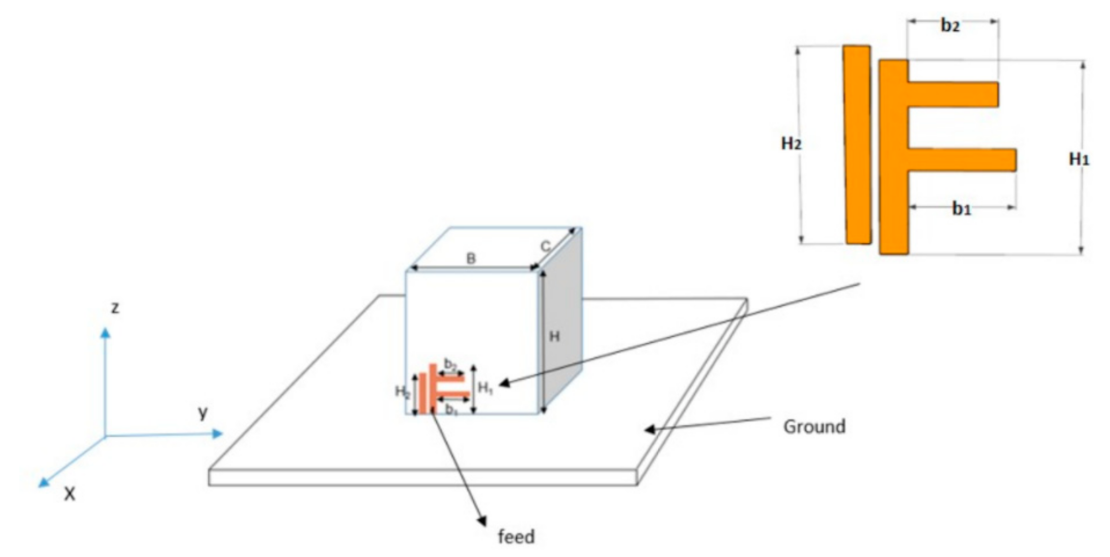
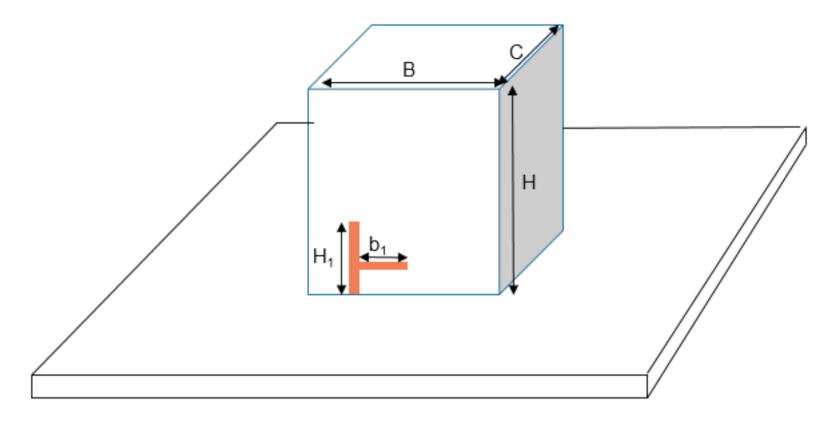

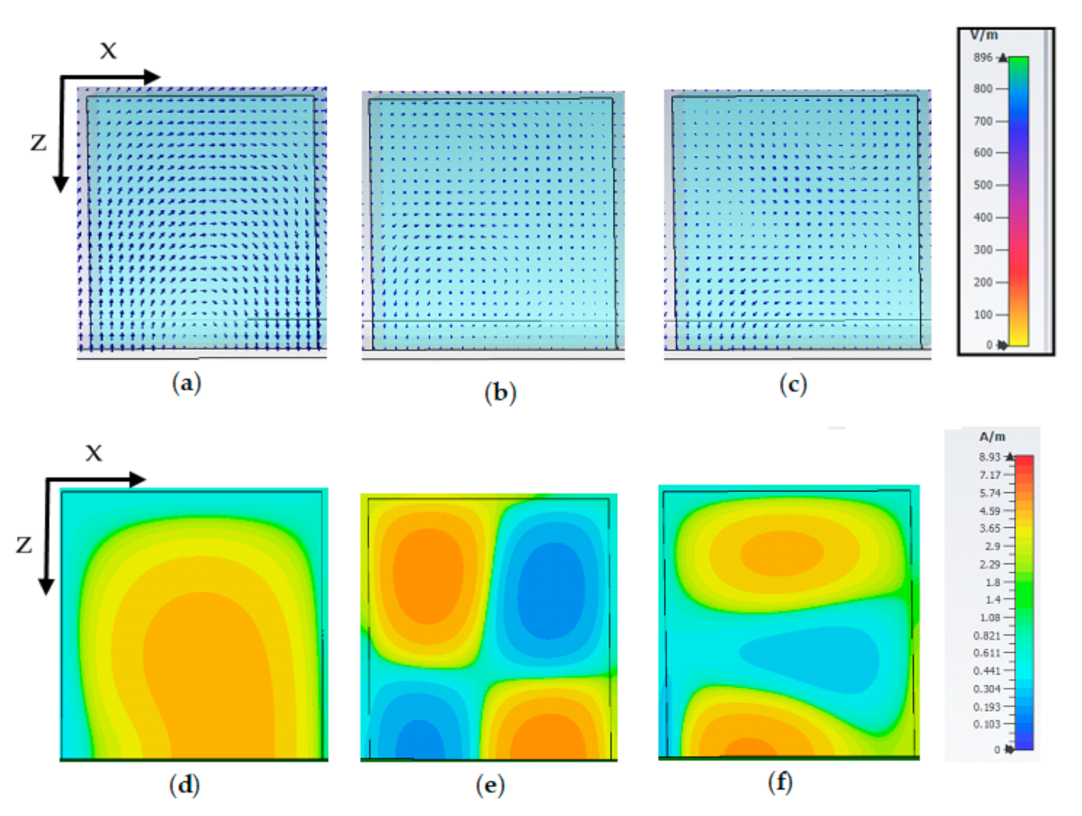
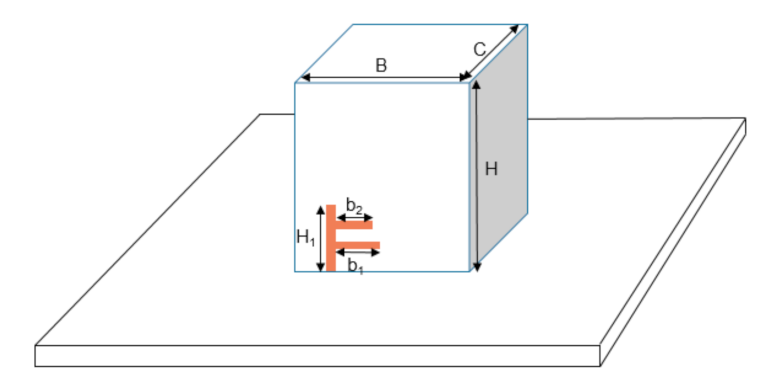
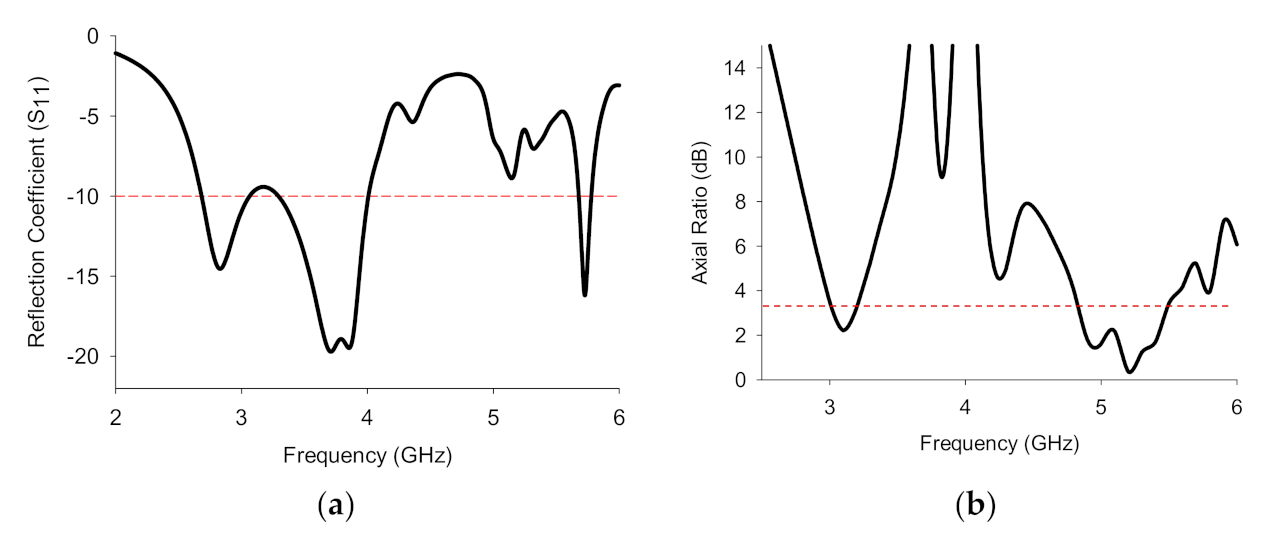
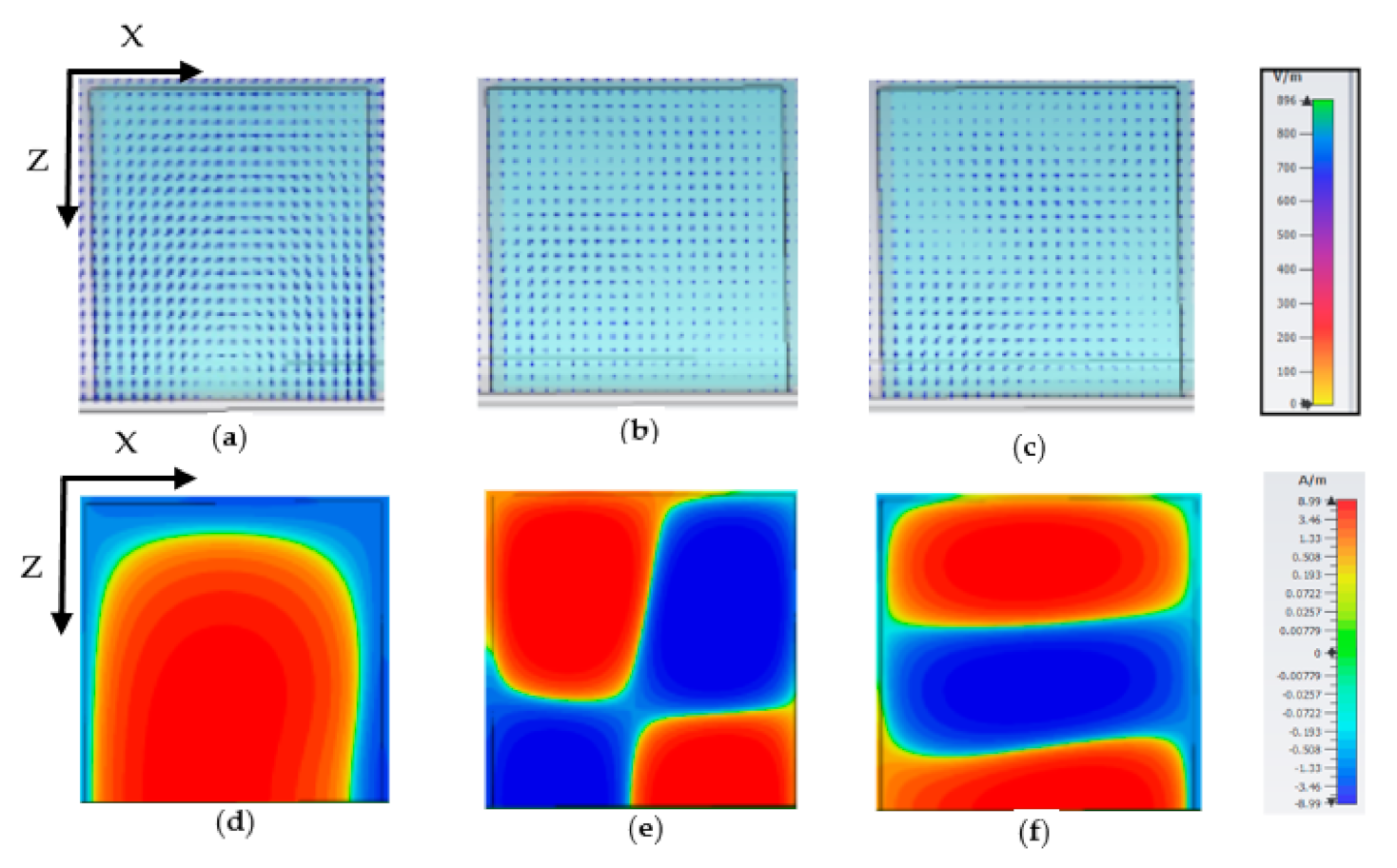
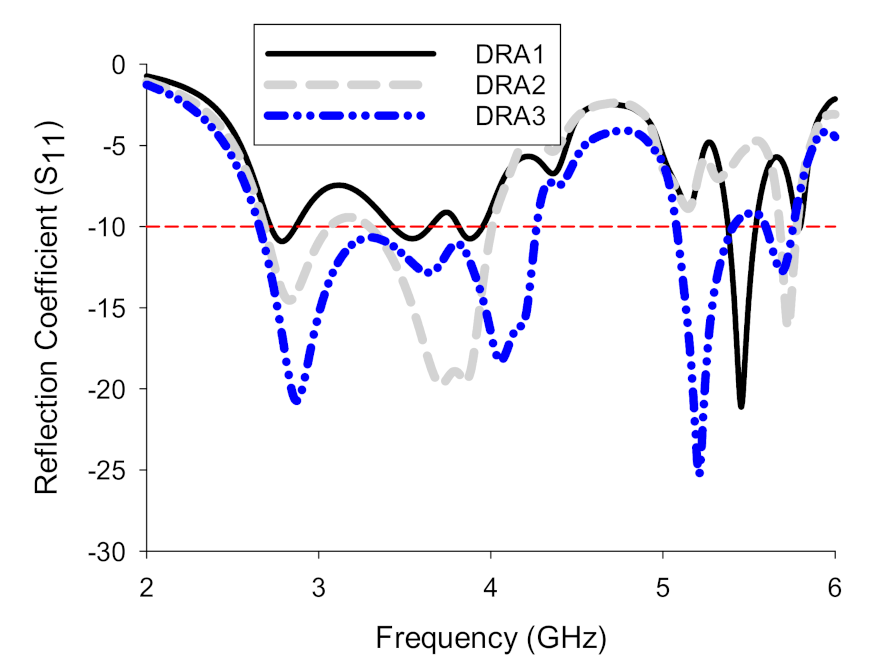
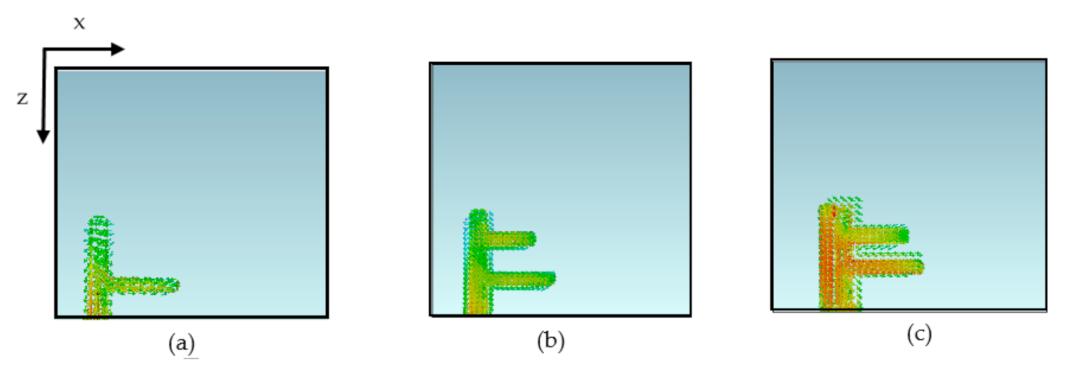
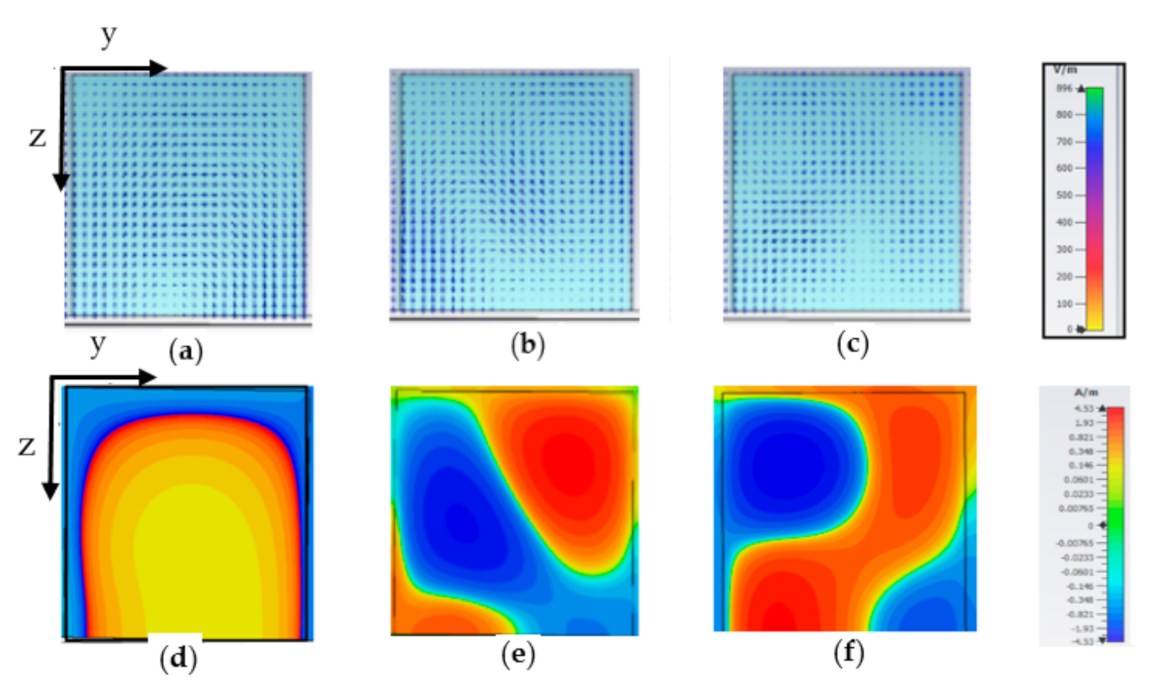
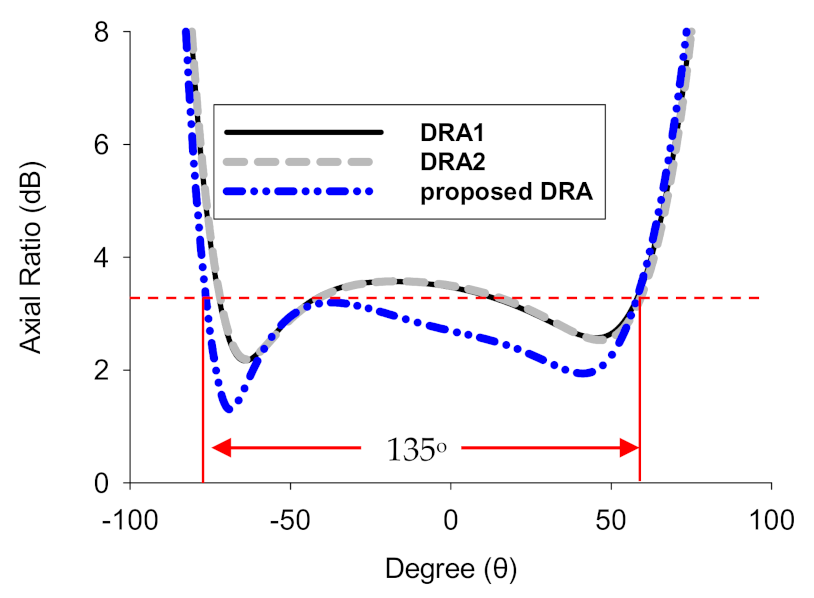
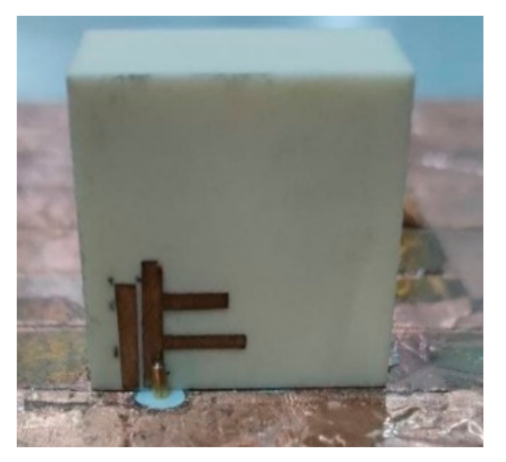
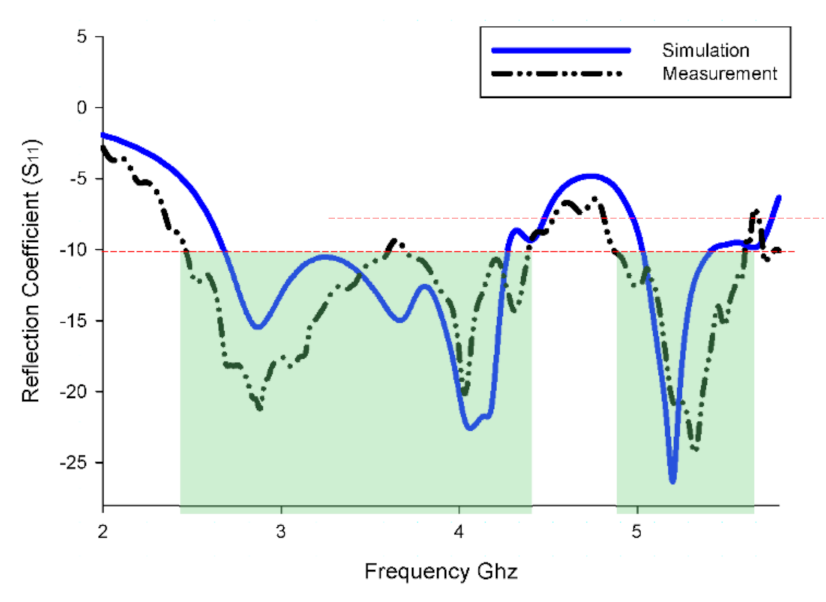
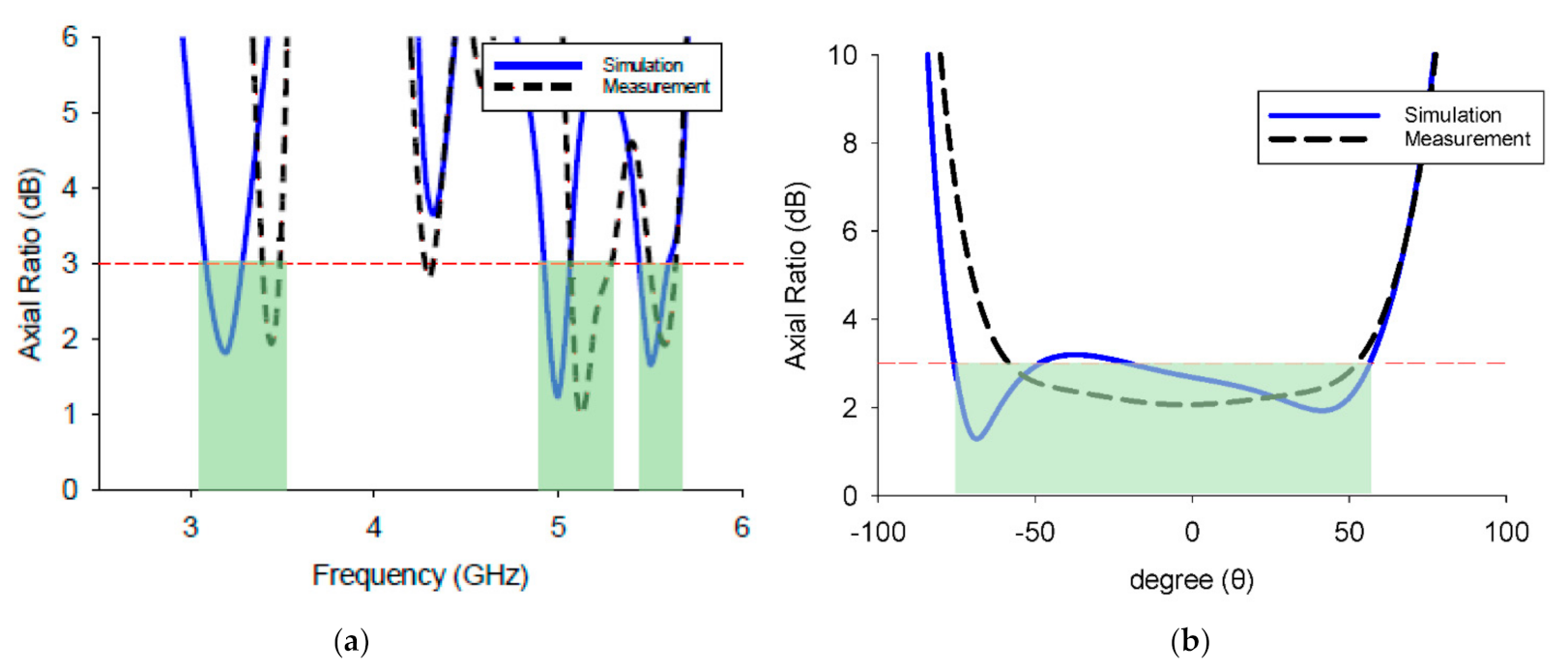

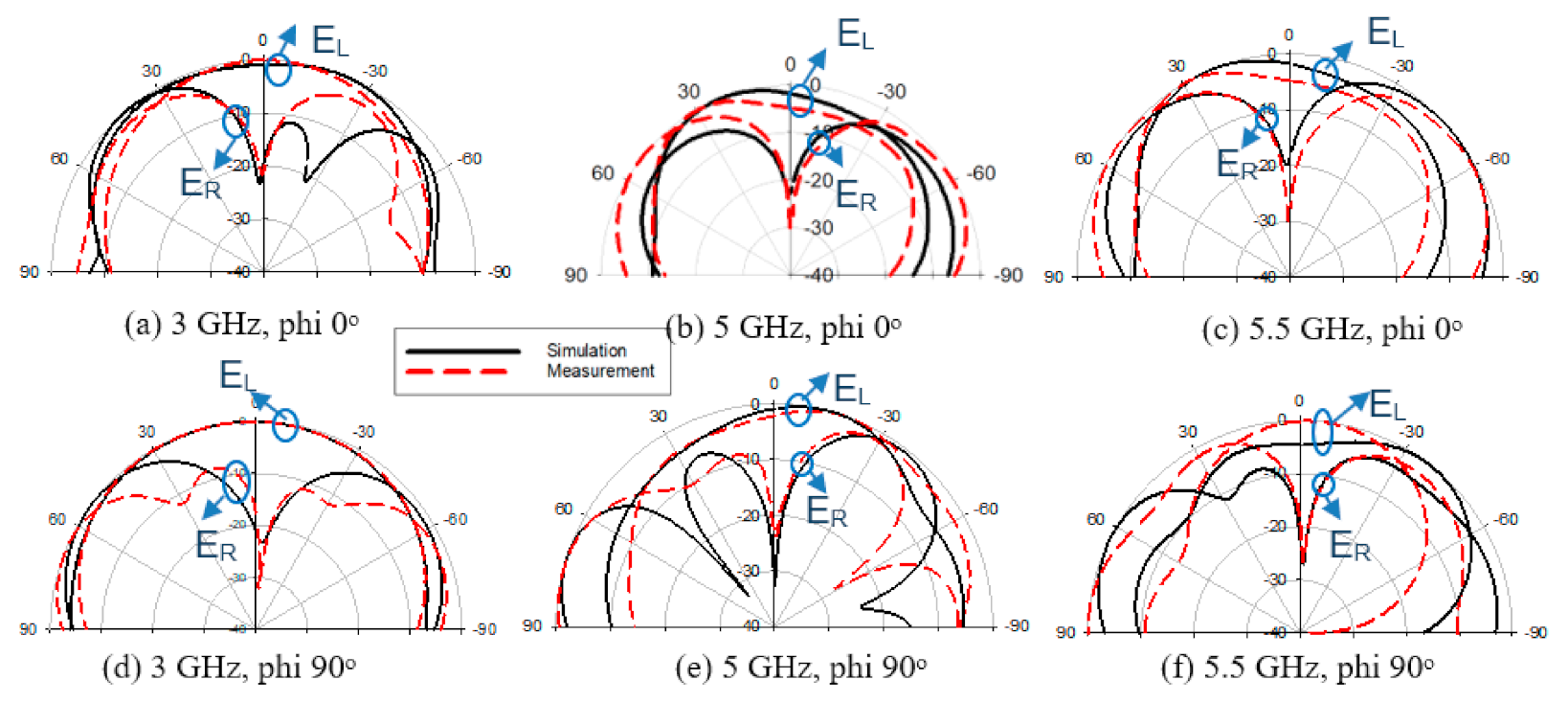
| Parameter | Dimension (mm) | Parameter | Dimension (mm) |
|---|---|---|---|
| B | 25.4 | H1 | 11 |
| C | 14.3 | H2 | 10.1 |
| H | 26.1 | b1 | 7.1 |
| b2 | 5.27 |
| Ref No. | Impedance BWs (GHz) (%) | 3 dB AR BWs (GHz) (%) | Peak Gain (dBic) | Size (λ0) | ||||||
|---|---|---|---|---|---|---|---|---|---|---|
| [3] | 1.71–2.03 [17.4] | 2.23–2.96 [28.13] | 3.65–3.76 [2.97] | 1.86–1.93 [3.96] | 2.67–2.82 [5.46] | 3.68–3.78 [2.15] | 5 | 5.28 | 2.36 | 0.44 × 0.5 × 0.16 |
| [5] | 1.45–1.87 [25.3] | 2.1–3.0 [35.3] | - | 1.53–1.63 [6.3] | 2.4–2.49 [3.68] | - | 6.1 | 8.49 | - | - |
| [6] | 1.77–2.0 [12.2] | 2.38–2.96 [21.7] | - | 1.76–1.94 [9.7] | 2.39–2.92 [20] | - | 5.5 | 6.0 | - | - |
| [10] | 1.92–1.96 [1.55] | 2.32–2.50 [7.68] | 3.42–3.55 [3.87] | 1.93–1.96 [1.55] | 2.36–2.48 [4.96] | 3.50–3.53 [0.8] | 1.2 | 1.6 | −1.5 | 0.32 × 0.32 × 0.15 |
| [16] | 2.12–2.45 [14.4] | 2.64–3.98 [40.5] | - | 2.29–2.44 [6.34] | 2.76–2.95 [6.65] | 3.67–3.94 [7.09] | 4.5 | 5.38 | 5.75 | - |
| [17] | 3.4–3.58 [5.16] | 5.1–5.9 [14.55] | - | 3.46–3.54 [2.28] | 5.18–5.34 [3.04] | - | 5.1 | 5.15 | - | 0.47 × 0.47 × 0.11 |
| Proposed | 2.43–4.35 [48] | 4.82–5.61 [14.8] | - | 3.18–3.29 [3] | 4.88–5.18 [4.5] | 5.28–5.45 [3.18] | 6.2 | 9.44 | 9.3 | 0.3 × 0.29 × 0.16 |
Publisher’s Note: MDPI stays neutral with regard to jurisdictional claims in published maps and institutional affiliations. |
© 2021 by the authors. Licensee MDPI, Basel, Switzerland. This article is an open access article distributed under the terms and conditions of the Creative Commons Attribution (CC BY) license (https://creativecommons.org/licenses/by/4.0/).
Share and Cite
Zambak, M.F.; Yasin, M.N.M.; Adam, I.; Iqbal, J.; Osman, M.N. Higher-Order-Mode Triple Band Circularly Polarized Rectangular Dielectric Resonator Antenna. Appl. Sci. 2021, 11, 3493. https://doi.org/10.3390/app11083493
Zambak MF, Yasin MNM, Adam I, Iqbal J, Osman MN. Higher-Order-Mode Triple Band Circularly Polarized Rectangular Dielectric Resonator Antenna. Applied Sciences. 2021; 11(8):3493. https://doi.org/10.3390/app11083493
Chicago/Turabian StyleZambak, Muhammad Fitra, Mohd Najib Mohd Yasin, Ismahayati Adam, Javed Iqbal, and Mohamed Nasrun Osman. 2021. "Higher-Order-Mode Triple Band Circularly Polarized Rectangular Dielectric Resonator Antenna" Applied Sciences 11, no. 8: 3493. https://doi.org/10.3390/app11083493
APA StyleZambak, M. F., Yasin, M. N. M., Adam, I., Iqbal, J., & Osman, M. N. (2021). Higher-Order-Mode Triple Band Circularly Polarized Rectangular Dielectric Resonator Antenna. Applied Sciences, 11(8), 3493. https://doi.org/10.3390/app11083493









